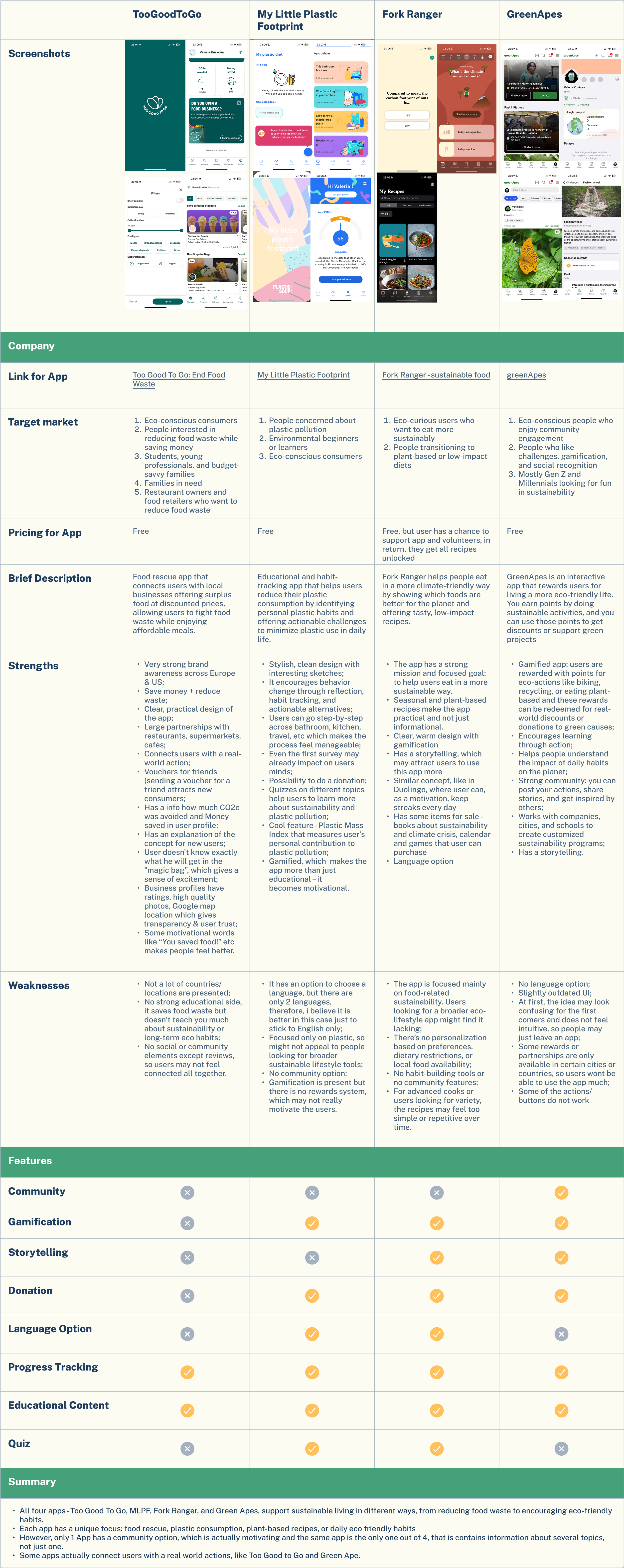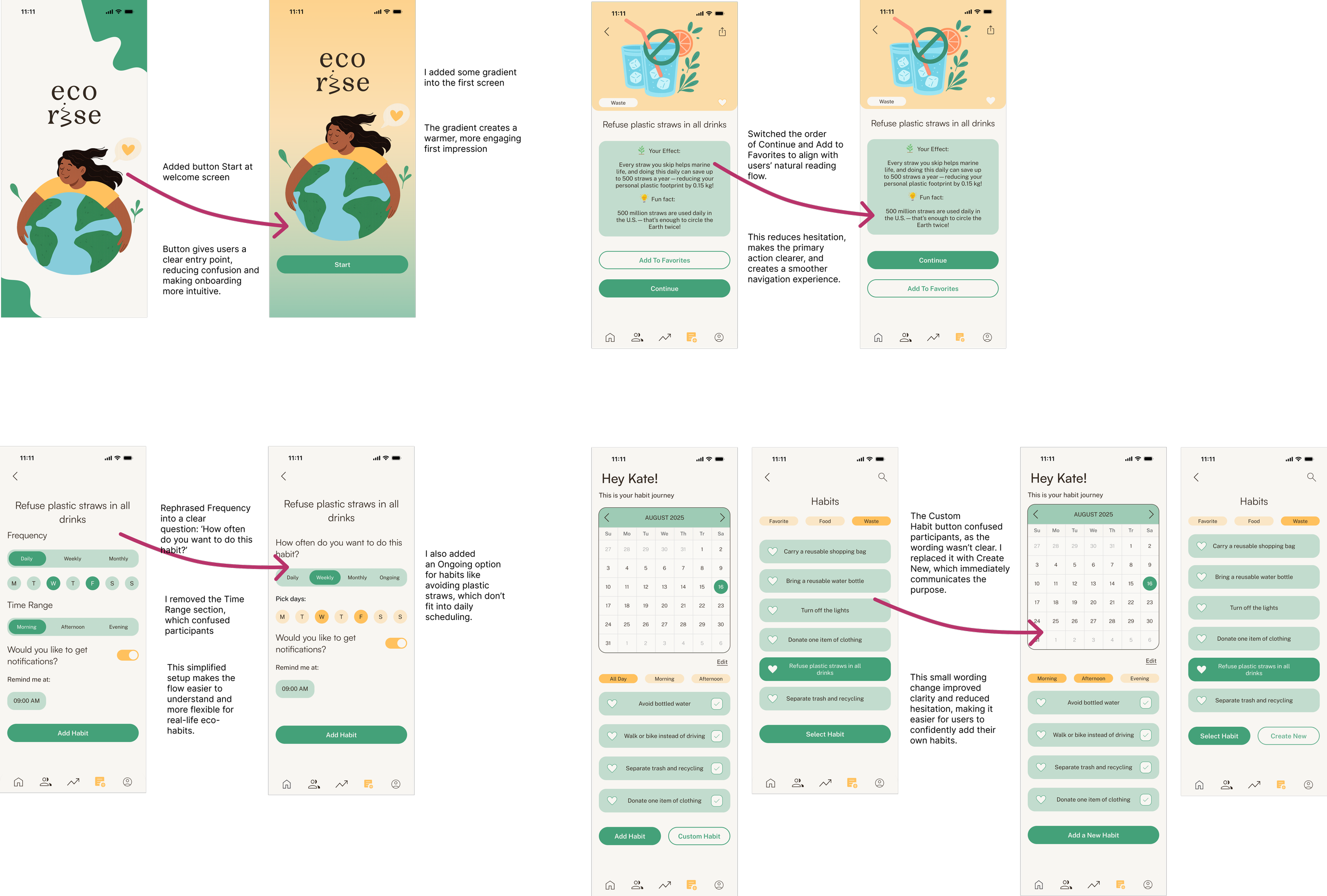ECORISE
EcoRise started with a simple observation: many people care about sustainability but often feel overwhelmed.
I designed this mobile app to make eco-friendly living simple, motivating, and community-driven - helping users turn small choices into lasting habits through clear tips and progress tracking.
Role: UX/UI Designer
Tools: Figma, FigJam
Duration: 08/2025 - 09/2025
Type: Individual Project
BACKGROUND
If we all know we should live more sustainably, why does it so often feel overwhelming and out of reach in daily life?
CONTEXT
Users want to live more consciously but lack the tools, guidance and motivation to do so consistently. They feel overwhelmed by too much information, guilty when they can’t keep up, and isolated without visible results or community support.
PROBLEM
Sustainability is on everyone’s mind, yet turning good intentions into daily action is still a struggle. Recycling often feels confusing, eco-friendly options can be costly or out of reach, and the realities of busy lives make it hard to stay consistent.
SOLUTION
A mobile app that helps people turn good intentions into daily action by:
Delivering quick, visual eco-tips that fit into busy routines
Offering habit tracking and progress feedback to make impact visible
Creating community challenges to boost motivation and belonging
COMPETITIVE ANALYSIS
I explored existing apps in the sustainability and habit-tracking space to see what they do well, where they struggle, and what patterns users already trust.
Tap image to view in details
KEY FINDINGS
-
Most sustainability apps focus on very specific areas (like food waste, plastic reduction, or recipes) but don’t provide a holistic approach. Only one app included a community feature, even though this was shown to be highly motivating for users.
-
Gamification, progress tracking, and educational content are common, but often treated in isolation. Successful apps connect users with real-world actions, which strengthens engagement. However, the lack of integrated features across all apps highlights a gap for a more unified and supportive experience.
USER INTERVIEWS
Simple guidance and visible progress make habits truly stick
In order to find out more, I conducted 5 interviews with people aged 24-49 years to understand how they think about and practice sustainability in daily life. Some were just starting with small eco-friendly actions, while others had built more consistent habits. The format was 5 remote interviews, each lasting 30-40 minutes.
RESEARCH GOALS
Understand what sustainable actions people already practice in daily life
Identify the main barriers that prevent people from building consistent eco-habits
Explore what kind of support and motivation helps people stay engaged
After conducting interviews, I organized findings through affinity mapping to identify patterns and pain points that weren't immediately obvious.
KEY FINDINGS
-
People care about sustainability but often feel guilty, skeptical or lost without clear guidance. Recycling rules, too much information, and lack of trust in systems make it hard to stay consistent.
-
Different triggers drive action - from animal welfare and pollution concerns to influencers and local role models. Still, acting together through events, groups, or visible results proved far more motivating than acting alone.
-
Users want quick, simple and local tips they can easily integrate into daily life. Strict or extreme approaches felt unrealistic, instead, they valued balanced solutions with clear progress and proof of impact.
THE STRATEGIC BREAKTHROUGH
Original approach:
Sustainability apps overload users with strict tasks or focus too narrowly.
➡️ Result: fragmented, overwhelming, inconsistent.
Our insight:
Motivation grows when habits are practical, trackable and socially reinforced.
➡️ Not when people feel guilty, pressured or lost.
What if…
Sustainable living felt simple, balanced, and supported by others -
instead of overwhelming and isolating? 🤔
USER PERSONA
Living greener while keeping life manageable: Kate’s story
Research showed that people want to live more sustainably, but struggle with clarity, consistency, and motivation in their daily routines. To bring these insights to life, I created Kate - a 26-year-old professional who cares about sustainability but often feels overwhelmed and unsure where to start.
Tap image to view in details
How might we help users build and maintain sustainable habits without overwhelming them?
PROJECT GOALS
From the HMW, I defined clear project goals, aligning user needs with business objectives to guide the design process.
SITEMAP
Mapping the app’s backbone for smooth user journeys
With clear goals in place, I mapped out the app’s structure to define its core features and navigation flow. The sitemap ensured that eco-tips, habit tracking, progress feedback, and community support were all logically organized, creating a foundation for the user flows and wireframes that followed.
Tap image to view in Figma
USER FLOWS
Visualizing real journeys behind sustainable habit building
The sitemap defined what the app would include. Next, I needed to map out how users would actually move through these sections to accomplish their goals, which led to creating detailed user flows.
Tap image to view in Figma
LO-FI SKETCHES & MID FIDELITY
I created low-fidelity sketches to explore structure, flows, and key features quickly. For several screens, I explored two different versions of the flow, comparing alternatives to see which best supported user needs. From there, I refined the strongest directions into mid-fidelity wireframes, adding hierarchy and usability details while keeping visuals minimal.
Tap image to view in Figma
UI KIT
A visual identity shaped by five core sustainability values
I crafted EcoRise’s design system to feel approachable, warm, and rooted in nature - a direct reflection of the app’s five core values: community, empowerment, mindful consumption, transparency, and consistency. The colors, typefaces, and logo together create a balance of clarity, motivation, and trust - guiding users toward sustainable habits with confidence.
Logo - minimal and soft, with a flowing “i” symbolizing the non-linear journey of habit building.
Colors - inspired by nature to bring growth, balance, and optimism.
Typeface - Satoshi provides structure and reliability, while Public Sans adds openness and inclusivity.
HIGH FIDELITY WIREFRAMES
I translated the refined wireframes into high-fidelity screens, applying EcoRise’s visual identity to create a design that feels clear, approachable, and motivating.
USABILITY FEEDBACK
Users loved the approachable design, clear eco-tips and motivating challenges, but there were a few refinements to make
Usability testing with 5 participants was focused on the core flow of adding a new sustainable habit (“Refuse Plastic Straws”).
All participants successfully completed the task , describing the experience as easy, intuitive, and visually engaging. Features like eco-tips, achievements, and challenges stood out as motivating and unique.
SUCCESS METRICS
ITERATION PRIORITIES
Overall, users found the flow easy and engaging. However, user testing also revealed small moments of friction - from unclear wording to missing entry points. These refinements became priorities to improve clarity and make the experience more intuitive.
Button Flow Optimization
Users found the order of “Continue” and “Add to Favorites” unclear - I switched their placement to create a smoother navigation flow.
Wording Misinterpretation
“Custom Habit” was misunderstood by participants. I replaced it with “Create New” to make the function more intuitive.
Missing Entry Point
Users asked for a clearer way to begin - I added a Start button on the first screen to reduce confusion.
Habit Setup Unclear
The “Time Range” section caused confusion. I removed it, rephrased “Frequency” into “How often do you want to do this habit?”, and added an Ongoing option for habits like “avoid plastic straws” that don’t fit daily scheduling.
FINAL DESIGN
FINAL PROTOTYPE
To bring the high-fidelity designs to life, I created an interactive prototype in Figma. This allowed me to demonstrate the app’s core flow - from habit selection to progress tracking in a realistic, clickable format. The prototype helped communicate the user journey more effectively to both mentors and test participants.
BRAND EXTENSION
To extend EcoRise’s impact beyond the app, I envisioned its branding on sustainable merchandise like tote bags and t-shirts, reinforcing eco-values in users’ daily lives 🌱
REFLECTION
What I Learned:
Starting with research reminded me how powerful it is to just listen to people’s real stories. Hearing why some felt guilty, overwhelmed, or motivated completely shaped the way I approached EcoRise.
User testing was a big lesson: feedback isn’t scary, it’s gold. Every single iteration came from something I observed, and that made the product stronger.
If I Did This Again:
I would explore more gamification features (badges, streaks) to further motivate users to maintain eco-friendly habits.
I’d refine the prototype interactions even more, simulating micro-interactions to better reflect the intended user experience.
I would run more A/B tests earlier on, so I could validate small decisions (like button order) before spending time polishing high-fidelity screens.


















